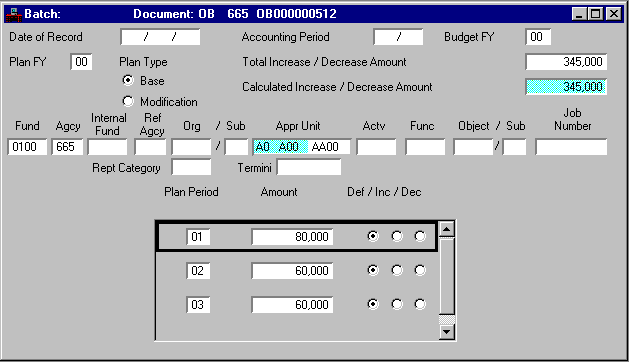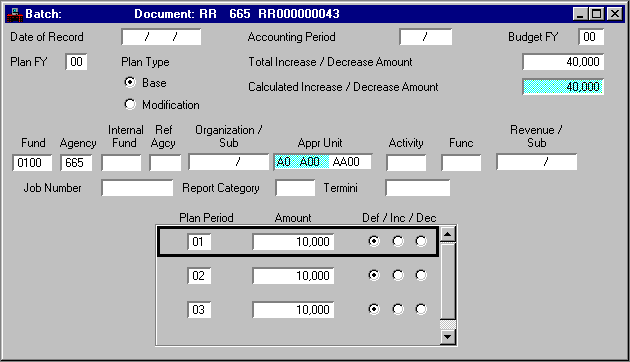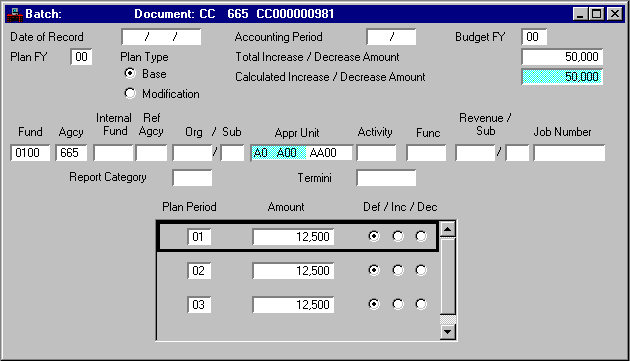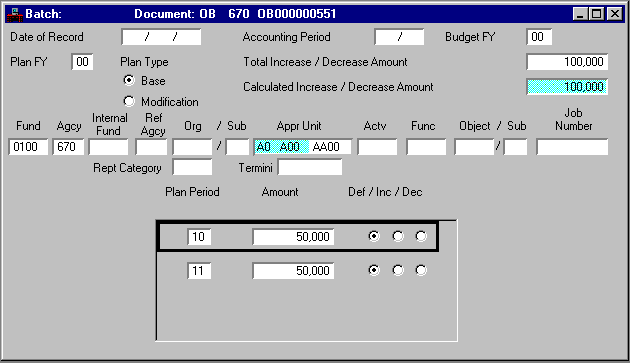 Planning
Planning



The planning module provides the capability to record financial goals and expectations for the current year and a future year. These plans can then be used in forecasting, budget preparation, or to test or measure financial management goals. In order to explain the planning module, this chapter will cover the following topics:
|
Explains the basic concepts involved with planning, such the differences between base and modified plans and how to set up a frequency for a plan. |
||
|
Describes the documents associated with the planning module and provides instructions for completing those documents. |
||
|
Using the Obligation Plan to Support Seasonal Spending Policies |
Provides instructions for effectively monitoring spending for seasonal activities. Examples demonstrate that plans may be configured differently, both in structure and amounts, than the budgets. |
See Using the Obligation Plan to Support Seasonal Spending Policies |
In many organizations, planning is either a precursor to or an extension of the budgeting process. In any event, it is a separate function because its purpose is to establish financial goals for different components of an organization, while budgets establish official control ceilings. Planning typically requires more flexibility than budgeting to define appropriate planning units. Planning targets may be different than budgetary ceilings.
Plans differ from budgets in that they do not imply or impose any controls on spending or revenue collection. They are informational only, used as management tools in developing a budget and in formulating spending/collection policies. They do not represent accounting events.
MARS includes three types of plans:
- Obligation plans for recording planned expenditures
- Revenue recognition plans for recording planned earnings (not necessarily collected)
- Cash collection plans for recording planned cash receipts
All three types of planning information are optional, and are not dependent on each other. They are also independent of all other modules. However, plans are still a part of the entire system because they use the codes and other data stored in tables.
Plan data is not maintained by tables. All plan detail is stored in the Plan Ledger. One record exists in this ledger for each original plan transaction and each modification. Custom reports can be written to obtain the information from this ledger.
MARS can store two versions of each of the three plan types:
- Base Plan. The original plan as developed at the beginning of a year (or planning period).
- Modified Plan. As the fiscal year progresses, forecasts for the remainder of the year may change. The modified plan contains your updated expectations for the year.
These two versions of the same plan let you keep the goals established at the beginning of the year, while at the same time revise your plans as conditions and goals change during the year. Financial managers use the base plan to compare actual results with original plans; they use the modified plan to forecast annual results and to compare those results with the budget.
At any point in the year, the modified plan amount of a line is the base plan adjusted by all increases and decreases submitted against the line. Any changes you make to the base plan are automatically reflected in the modified plan. Of course, when changes are made to the modified plan, they are not reflected in the base plan (see the example that follows).
Plan lines with zero and negative amounts are valid. These amounts are the result of decreasing previously entered lines, or coding an original line with a zero amount (leave the Default/Increase/Decrease indicator blank on the plan document) or negative amount (select Dec in the Default/Increase/Decrease indicator on the plan). You can enter a change to any plan line (modified or base) at any time during the year; although once a base plan is set up and approved, it is not usually changed.
Plan Frequency and the Plan Period
A plan can be built for an entire fiscal year, for fiscal quarters, or for fiscal months. These time periods, called plan periods, are selected separately for each fund/agency combination. The selection is recorded in Fund Agency (FGY2), in the Plan Frequency column. The valid values are:
- Yearly . Plans for this fund/agency are for an entire year; the plan period on the plan documents must be 1 or 01.
- Quarterly . Plans for this fund/agency are for a specific fiscal quarter in the plan year; valid Plan Periods on the plan documents are:
- 1 or 01 for first fiscal quarter
- 2 or 02 for second fiscal quarter
- 3 or 03 for third fiscal quarter
- 4 or 04 for fourth fiscal quarter
- If your budget fiscal year begins in July, then the months July through September are represented by 1 on the plan documents.
- Monthly . 12 or 13 planning periods exist (12 if your fiscal months correspond to calendar months; 13 if your fiscal months are always 4-week periods); valid plan periods on the plan document are:
- 1 or 01. Represents first fiscal month
- 12/13. Represents Last fiscal month
- If your budget fiscal year starts in July, July is represented by 1 on the plan documents.
- None. There are no planning periods for the fund/agency.
Establishing Planning Units and Coding Plan Lines
Planning units are created by defining them on documents. At a minimum, each planning unit is defined by Fund and Agency. In addition, plans may be defined by Appropriation Unit, Organization within Agency, Sub-Organization, Activity, Function, Object of expenditure, Sub-Object, Revenue source, Sub-revenue source, Job Number, Reporting Category, Termini, and internal reference Fund and Agency. Any combination of the above is also valid. The definitions of planning units are completely flexible so that planning may be performed in the manner appropriate to each element of an organization. Within the same agency, for example, one unit of appropriation may represent a single planning unit, while another unit of appropriation may be divided into several planning units, such as by organization or object.
The Job Number field must be valid in Job Inquiry (1 of 2) (JOB2). General Reporting Category codes must be valid in general Reporting Category (RPTG) for both the budget and plan years specified on the form.
MARS lets you establish your own planning structure and level of detail and vary it according to the needs of your planning process. Planning units may even overlap each other, if desired.
The level of detail used for planning is independent of both budgeting and accounting. You may plan in more or less detail than when you budget. Your planning units may be as detailed as your cost accounting distributions, if you desire. Any reports that compare actuals against plans can be summarized to the level where the two are consistent.
New plan units are added to a plan by coding a new combination of codes in the header section of a plan document. Changes to existing lines in a plan are made by entering all codes in the header section of the form exactly as they were coded originally, and indicating the amount of change in the line level of the document. The codes in an existing line cannot be changed; the line amount must be reduced to zero, and then a new line must be entered.
Plan lines are not governed by any MARS system controls or options. Negative line amounts are valid.
All plan transactions are stored in the Plan Ledger, as one-line entries. The line amount used is the Calculated Increase/Decrease amount.
Plan transactions do not affect (update) any tables, and the data is not available for online inquiry. Plan data is available through reports only.
Preparing a Plan for a Future Fiscal Year
To prepare a plan for a future fiscal year, enter base plan lines on documents, using the future year as plan year and budget year.
To implement any of the three plans, take the following steps:
- Decide, for each fund/agency combination, whether plans will be recorded by year, by quarter, or by accounting period. Record these choices in the Plan Frequency field of Fund Agency (FGY2).
- Prepare the initial plan by coding base plan lines on documents.
- Request reports to review the plan. Make any desired changes to the base or modified plan. Changes can be made as often as necessary to keep the plan current.
You can change amounts of an existing line in a plan by entering all codes in the header section of the form exactly as they were entered originally, and indicating the amount of change in the line level of the document. You cannot change the codes in the header of an existing document. You also cannot delete a line from a plan; for example, you cannot remove the accounting distribution from the Plan Ledger, although you can change the line amount to zero. (The line is essentially deleted from the plan if the reports are written to exclude accounting distributions with a line amount of zero).
You add a new line (a new accounting distribution) to a plan by entering a new combination of codes on the header section of a plan form.
- Since nothing on the window indicates whether you are adding new lines or changing existing lines, there is no way for MARS to know whether you are adding a new line, or if you made a mistake in coding a change. If you enter a combination of codes that already exists in the plan, MARS treats it as a change. If you enter a combination of valid codes that does not exist in the plan, MARS treats it as a new line.
Obligation Plan (OB) documents record spending targets (expenditures plus outstanding encumbrances) by planning period for each user-defined obligation planning unit. You can establish two sets of plans simultaneously: one for the fiscal year in progress and one for the next (budget preparation) fiscal year. Obligation plans for all prior years that are open for accounting transactions are also available for reporting purposes.
If you budget and account for expenditures on an obligation basis, expenses resulting from prior year encumbrances should be planned in the period when the obligation is incurred, rather than the period when the goods or services are received.
Figure 137 shows a sample obligation plan document coded to record an initial base plan for fund 0100 and agency 665, for the entire year, for a plan frequency of Quarterly on Fund Agency (FGY2) (four plan periods).

The Revenue Recognition (RR) document records targets for revenue recognition (revenue earned) by planning period for each user-defined revenue planning unit. You can establish two sets of plans simultaneously: one for the fiscal year in progress and one for the next (budget preparation) fiscal year. In addition, revenue recognition plans for all prior years remaining open for accounting transactions are also available for reporting purposes.
Since revenue from certain sources, such as federal or state grants, may be recognized on an accrual basis, the recognition of such revenues should be planned in the period when the revenue is earned (accrued) rather than the period when the cash is received. (In the case where revenue collections are received in advance, the period when the revenue recognition is planned is generally later than the period when the collection is planned.)
Figure 138 shows a sample revenue recognition plan turnaround form completed to record an initial base plan for fund 0100 and agency 665, for the entire year, for a plan frequency of Quarterly ; for example, four plan periods.
Revenue Recognition (RR) Document

Cash Collection Plan (CC) documents record collection targets by planning period for each revenue planning unit. You can establish two sets of plans simultaneously: one for the fiscal year in progress and one for the next (budget preparation) fiscal year. In addition, cash collection plans for all prior years remaining open for accounting transactions are also available for reporting purposes.
Figure 139 shows a sample Cash Collection Plan (CC) document completed to record changes in the modified plan for the ninth through twelfth accounting periods.
Cash Collection Plan (CC) Document

Using the Obligation Plan to Support Seasonal Spending Policies
Plans are used for tracking seasonal trends that may not be available or obvious when making comparisons to the annual budget. Seasonal spending for such activities as snow removal, security, and recreation activities are examples of items that are more effectively monitored by the planning module. Plans may be configured differently, both in structure and amounts, than the budgets. For example, you may plan at the Agency level and budget at the Organization level, with amounts that are not required to be equal.
Figure 140 shows an obligation plan developed by agency 665 for employee summer recreation activities (program AA00). The plan reflects a management decision that one half of the budgeted amount ($100,000) for this activity should be obligated in April (period 10) and May (period 11) in order to plan and prepare for the summer activity.

Forecasting reports are written to highlight and force attention on potential problem areas where budget changes or reallocations may be justified. Forecasted amounts may also prove helpful as a basis for preparing a budget for a future year.
Forecasted amounts can be represented as the sum of actual results (actual obligations/recognitions/collections) year-to-date plus the current modified plan amount for the remainder of the fiscal year. Therefore, forecasts can be continually updated as the year progresses.